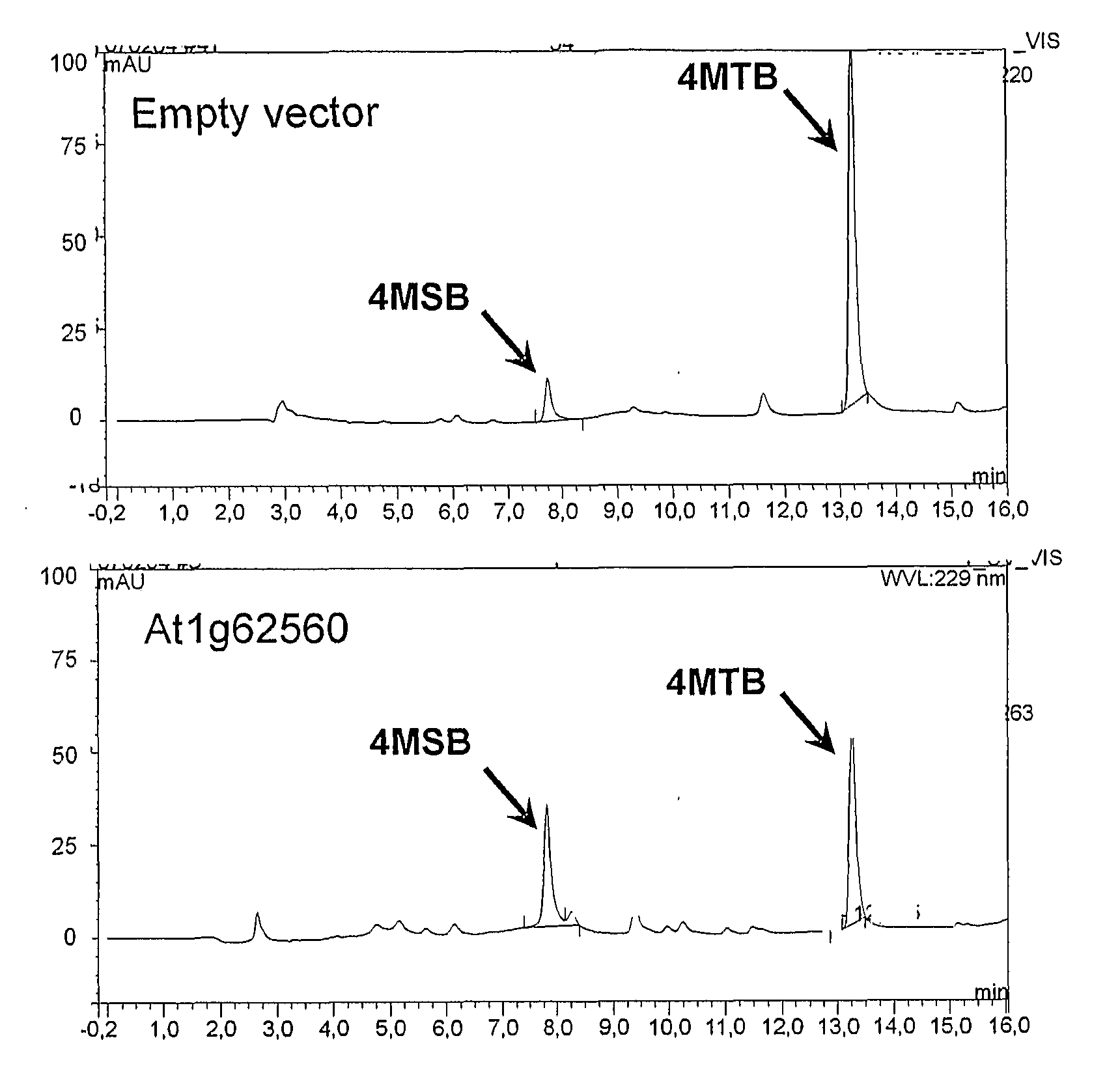Flavin monooxygenases and transcription factors involved in glucosinolate biosynthesis
a technology of transcription factors and flavin monooxygenases, applied in the field of polypeptides, can solve the problems of goitre-like symptoms and limit the use of rapeseed meal
- Summary
- Abstract
- Description
- Claims
- Application Information
AI Technical Summary
Benefits of technology
Problems solved by technology
Method used
Image
Examples
example 1
the identification of candidate genes for catalyzing the conversion from 4-methylthiobutyl glucosinolate to 4-methylsulphinyl glucosinolate
[0302]The “Transcript Co-response single gene query” of CSB-DB—(a comprehensive systems-biology database) (http: / / csbdb.mpimp-golm.mpg.de / index.html) were used to identify genes co-expressing with the genes in the biosynthesis of aliphatic GSLs (including At4g13770, At1g16410 and At1g16400). Two flavin-containing monooxygenases (At1g65860 and At1g62560) were among the genes that were identified, and these genes were also inside a 17cM QTL for conversion of methylthioalkyl to methylsulfinylalkyl GSL (Kliebenstein et al., Plant Physiology, 126, 811-825, 2001). Since catalysis of this type of reaction is consistent with FMO activity they were elected for characterisation.
example 2
Enzymatic Activity Of Heterologously Expressed FMOs
[0303]FIG. 3 shows the enzymatic activity of heterologously expressed At1g65860 in E. coli spheroplasts. The results clearly show the production of 4MSB from 4MTB by the transformed microorganisms.
[0304]FIG. 4 shows the ratios of sulphinyl / thio GSLs for each specific chain length in Arabidopsis thaliana offspring from a heterozygous segregating knock out in At1g65860 (Salk line 079493). The results clearly show that the FMO encoded by At1g65860 is capable of converting 4- and 5-MTB into 4- and 5-MSB. It is believed that other homologues may have different specificities.
[0305]FIG. 5 shows 4MTB levels in leaves from wild type and transgenic At1g65860 and At1g62560 overexpression lines. The results clearly show that the FMO encoded by these genes catalyse the conversion of 4MTB to 4MSB in leaves.
[0306]Table 1a shows the GS-OX activity of the At1g65860 T-DNA knock-out mutant. Seeds and leaves of plants were analyzed for GSL content. All...
example 3
Activity of the FMOs Against Other Substrates
[0308]In addition to 4MTB and desulfo-4MTB (see above) the possibility that the oxygenation of the sulfur might take place at an earlier step in the GSL biosynthesis was also tested. Substrates tested were methionine, one chain-elongated methionine (dihomomethionine) and 4-methylthiobutyl oxime. No oxygenation on the sulfur of any of these was observed suggesting that oxygenation takes place on the intact GSL or on the desulfo-methylthioalkyl-GSL in planta.
PUM
| Property | Measurement | Unit |
|---|---|---|
| GSL-biosynthesis | aaaaa | aaaaa |
| length | aaaaa | aaaaa |
| aliphatic | aaaaa | aaaaa |
Abstract
Description
Claims
Application Information
 Login to View More
Login to View More - R&D
- Intellectual Property
- Life Sciences
- Materials
- Tech Scout
- Unparalleled Data Quality
- Higher Quality Content
- 60% Fewer Hallucinations
Browse by: Latest US Patents, China's latest patents, Technical Efficacy Thesaurus, Application Domain, Technology Topic, Popular Technical Reports.
© 2025 PatSnap. All rights reserved.Legal|Privacy policy|Modern Slavery Act Transparency Statement|Sitemap|About US| Contact US: help@patsnap.com



